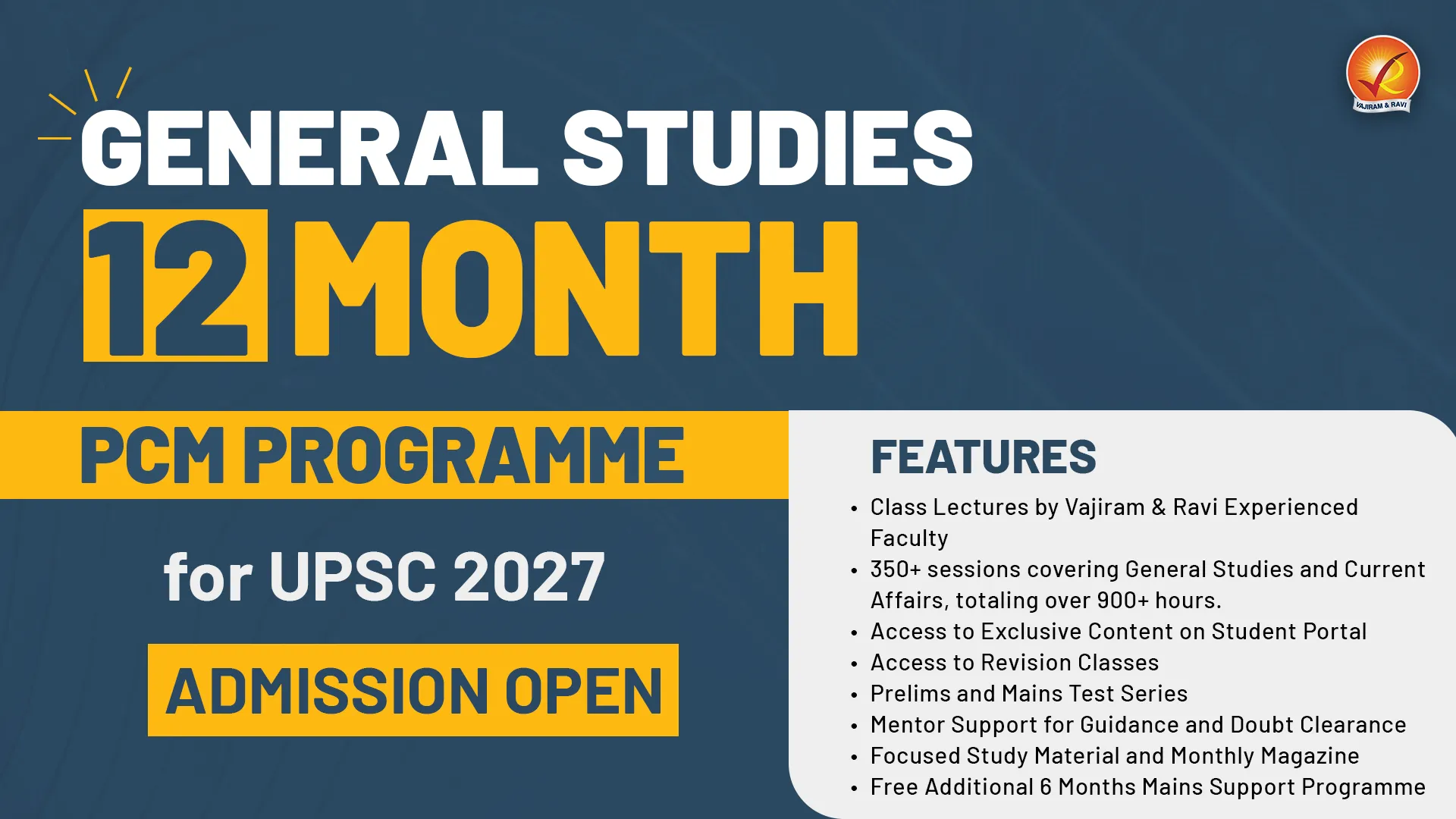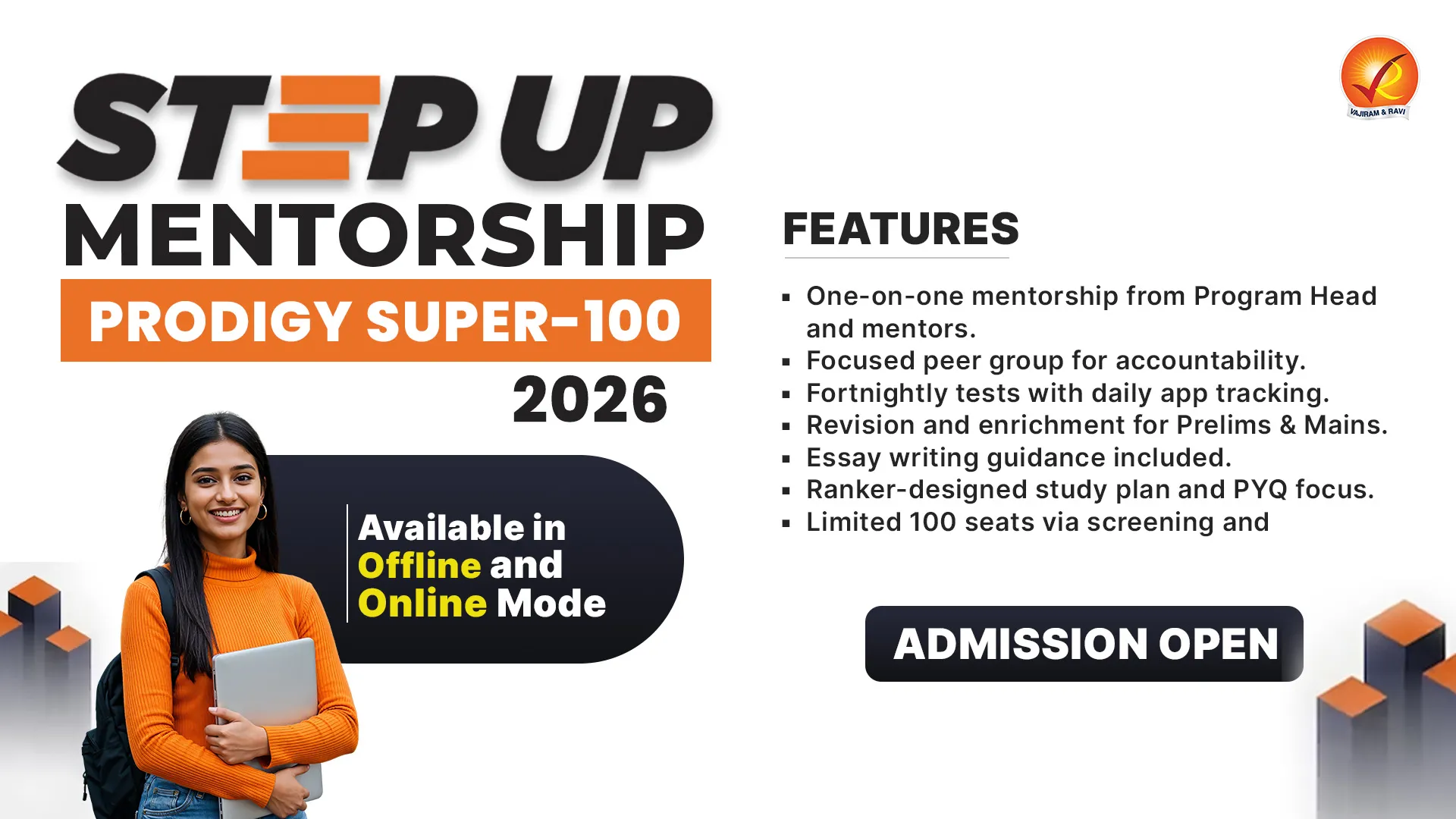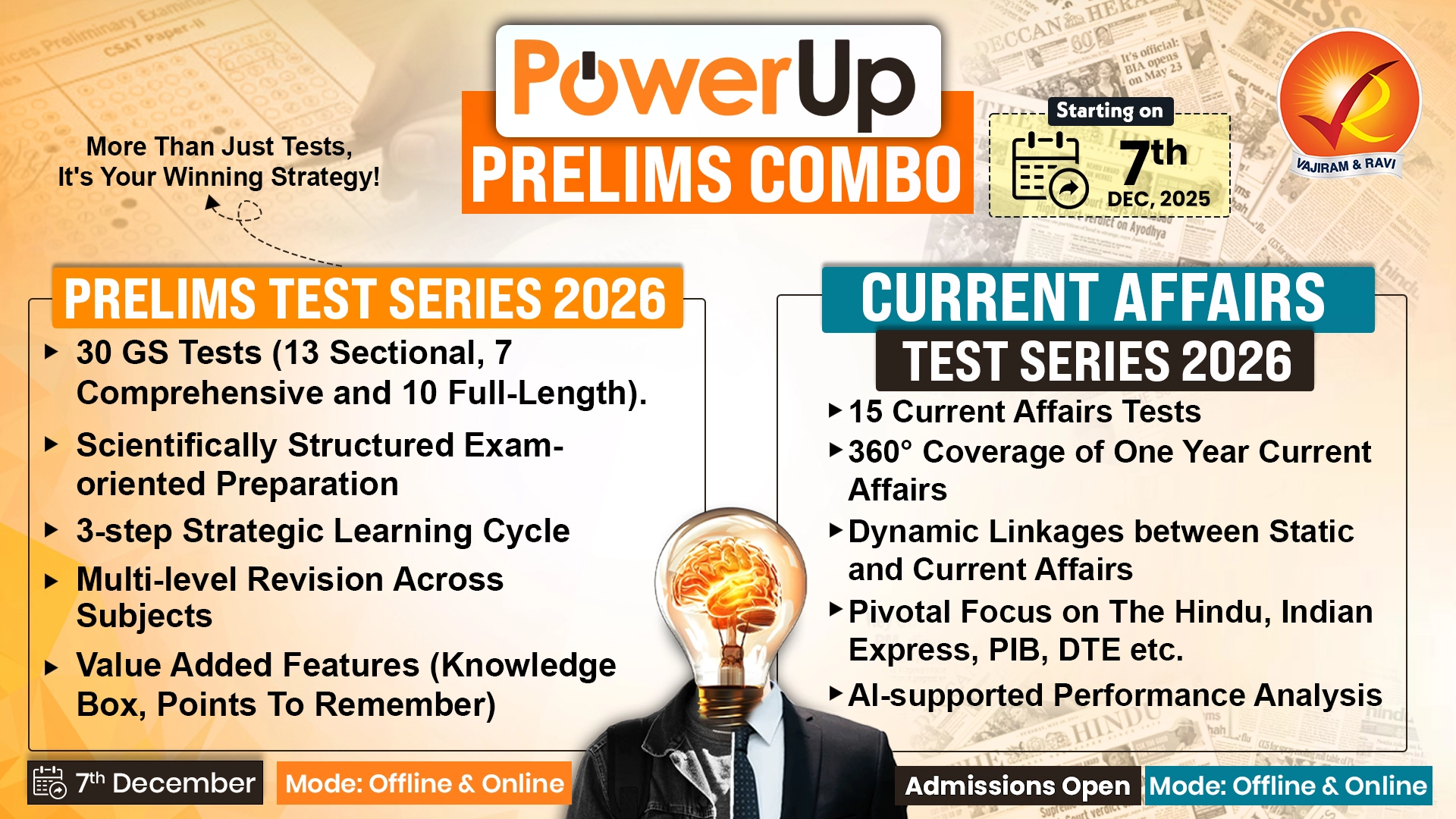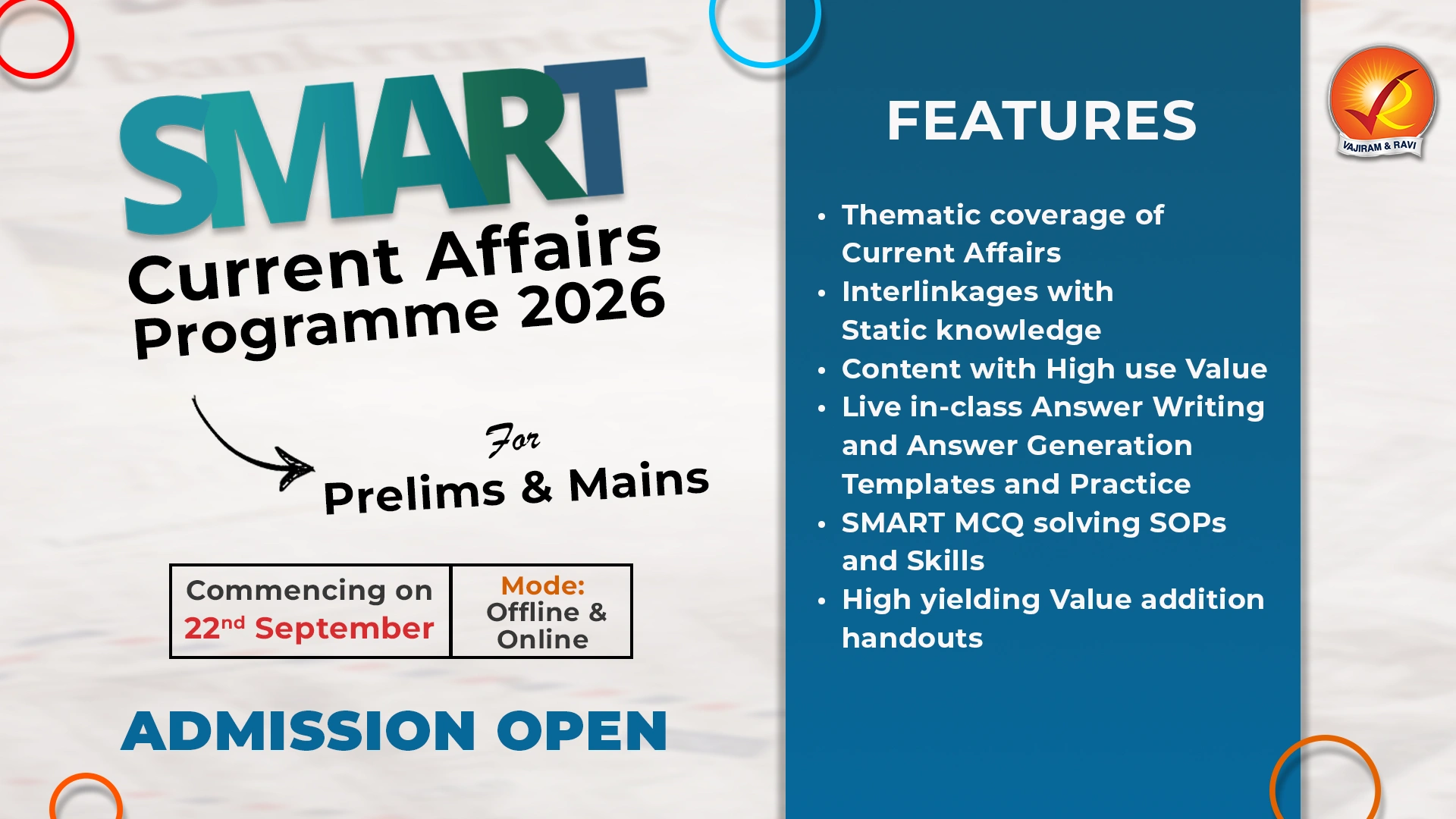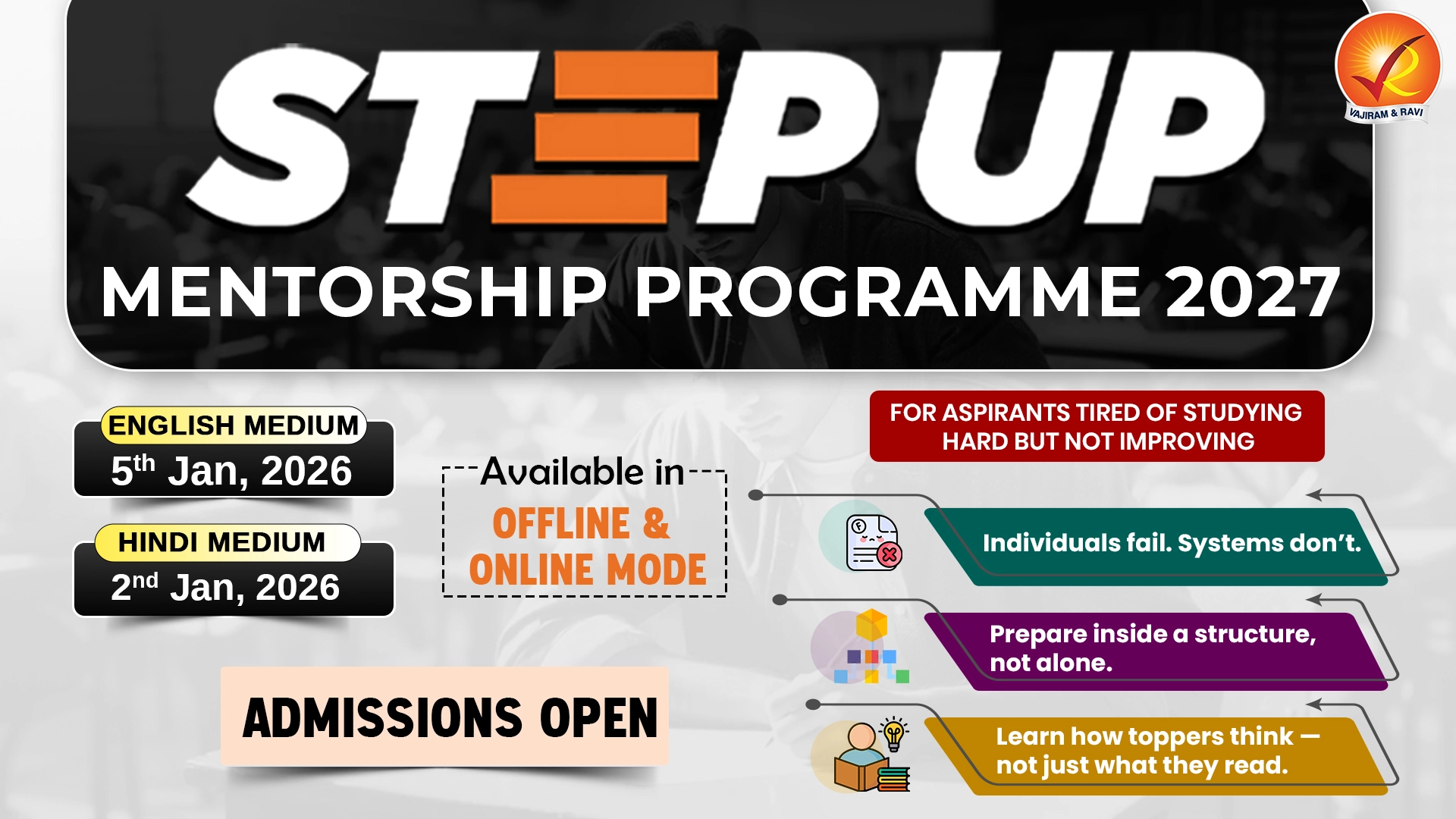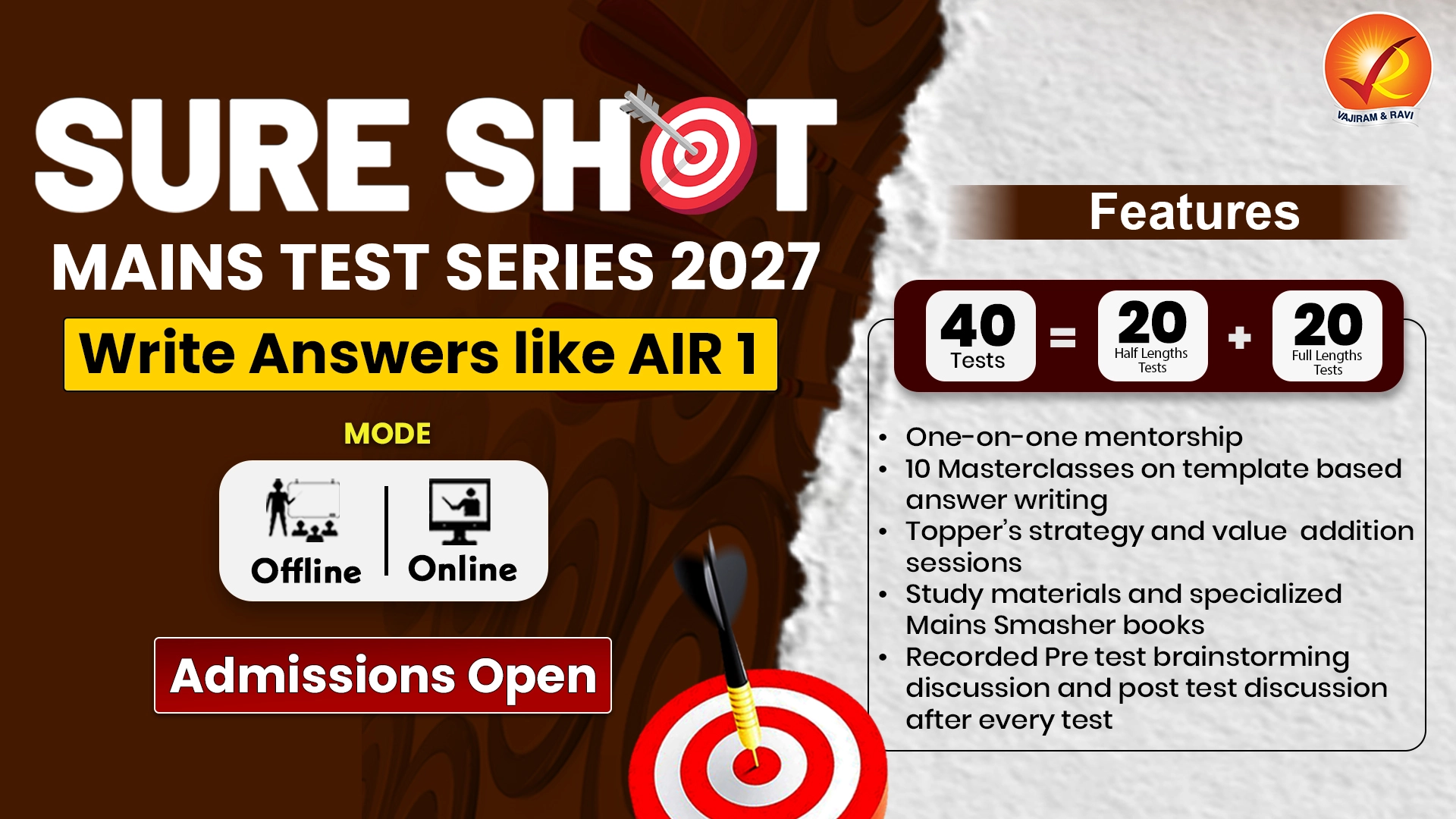Upcoming Mentoring Sessions
Learning Support Session - ANSWER writing MASTER Session
Learning Support Session - How to Read Newspaper?
Mastering Art of writing Ethics Answers
Mastering Art of Writing Social Issues Answers
Answer Review Session
RMS - Economy 11 - Infrastructure
RMS - Art & Culture 3
RMS - Polity 7 - Parliament 3
RMS - Geography - Indian Physiography - 2
RMS - Economy 10 - Agriculture
RMS - Polity 7 - Parliament 2
RMS - Geography - Indian Physiography
RMS - Polity 7 - Parliament 1
RMS -Economy 9 - Fundamentals of Indian Economy
RMS - Geography 5 - Major Landforms
RMS - Art & Culture 2
RMS - Geography 4 - Volcanoes, Volcanic Landforms and Rocks
RMS - Polity 6 - Judiciary 2
RMS - Economy 8 - Trade and Important Government Schemes
RMS - Geography 3 - Evolution of Oceans and Continents
RMS - Economy 7 - Inflation
RMS - Polity 6 - Judiciary 1
RMS - Geography 2 - Basic Concepts of Universe & Earth Interior
RMS - Art & Culture 1
RMS - Economy 6 - Balance of Payment
RMS - Geography 1 - Geomorphic Processes
RMS - Polity 5 - Constitutional & Non-Constitutional Bodies
Mentoring Session - UPSC Form Filling
RMS - Economy 5 - Financial Markets
RMS - Polity 4 - Fundamental Rights - P3
RMS - Economy 4 - Fiscal Policy and Budgeting
RMS - History 2 - From 1765 to 1858 - P2
RMS - Polity 4 - Fundamental Rights - P2
RMS - Economy 3 - Taxation
RMS - Polity 4 - Fundamental Rights-P1
RMS - History 1 - European Penetration to Battle of Buxar
RMS - Economy 2 - Money & Banking - P2
Mentoring Session (2024 - 25) - How to Write an ESSAY?
Social Issues Doubts and Mentoring Session
Ethics & Essay Doubts and Mentoring Session
Geography & Environment Doubts and Mentoring Session
History Doubts and Mentoring Session
Economy & Agriculture Doubts and Mentoring Session
Online Orientation Session
How to Read Newspaper and Make Notes?
Mains Support Programme 2025-(2)
Mains Support Programme 2025- (1)
Polity & International Relations Doubts and Mentoring Session
Mentoring Sessions (2024-25) - How to DO REVISION?
RMS - Polity - Parliament 3
Learning Support Session - How to Start Preparation?
RMS - Geography - World Mapping
RMS - Polity - Parliament 2
Prelims 2024 Strategy Session
RMS - Polity 3 - Union & its Territories and Citizenship
RMS - Geography - Major Landforms
RMS - Polity 2 - Preamble
RMS - Economy 2 - Money & Banking - P1
Mentoring Session (2024-25) - How to Make Notes?
RMS - Polity 1 - Constitution & its Salient Features
General Mentoring Session (GMS )
RMS - Modern History - Constitutional Developments - Important Acts in British India
Mentoring Session (2025-26) - How to write an Answer?
RMS - Economy 1 - Fundamentals of Economy and NIA
Article
16 Dec 2025
Context:
- December 12 is observed as Universal Health Coverage (UHC) Day, highlighting the global commitment to ensuring access to essential health services without financial hardship.
- The 2025 theme — “Unaffordable health costs? We’re sick of it!” — underscores growing public frustration over rising healthcare expenses and persistent out-of-pocket expenditure (OOPE).
Universal Health Coverage (UHC) vs Universal Healthcare:
- UHC: Focuses primarily on financial risk protection, often through insurance schemes covering hospitalisation and select treatments.
- Universal healthcare: A broader concept ensuring equitable access to comprehensive primary healthcare, including preventive, promotive, curative, rehabilitative, and palliative care. Thus, having ‘Right to Health’ at its core.
Global Normative Framework:
- Right to Health recognised in international covenants. For example, Alma-Ata Declaration, 1978 (WHO) emphasised Primary Healthcare (PHC) as the foundation of health systems.
- WHO World Health Report, 2010 shifted focus towards financial reform and insurance-based risk protection.
- UN Resolution on UHC and SDGs institutionalised UHC as a global development goal (SDG 3).
Insurance-Centric UHC - Emerging Concerns:
- Many countries, including India, have adopted public health insurance-led UHC.
- These schemes focus on hospitalisation and disease-specific packages, but often exclude outpatient care, diagnostics, and medicines.
- Evidence shows continued OOPE due to -
- Services not covered or inadequately covered
- Provider-induced demand and misuse of insurance packages
- This means, financial protection without system strengthening is inadequate.
Comparative Experience - East and Southeast Asia:
- Countries like China and South Korea achieved near-universal insurance coverage.
- However, fiscal burden on the exchequer became unsustainable, and ageing populations and chronic diseases increased costs.
- China’s course correction (2015):
- Cost containment
- Strengthening primary and secondary care
- Focus on prevention, early detection, follow-up
- Investment in human resources and population outreach
- Lesson: Insurance works best when anchored in a well-financed public health system with PHC as a gatekeeper.
Role of Public Health Systems:
- East and Southeast Asian countries maintain strong public provisioning, and a regulated private sector.
- A robust public system must act as a bulwark against cost escalation, and help regulate quality and pricing.
- Yet, private sector influence on health policy remains an unresolved concern.
India’s Historical Commitment and Policy Drift:
- Bhore Committee (1946): Advocated universal healthcare through a strong public PHC system. It explicitly cautioned against introducing insurance before PHC strengthening.
- Post-Independence reality: Chronic underfinancing of primary healthcare, weak public provisioning, and growing dependence on private healthcare.
- National Sample Survey (NSS): Increasing reliance of the poor on expensive private care. Rising household indebtedness due to health expenses.
Health Reforms in India:
- National Rural Health Mission (NRHM, now NHM): Improved access but systemic gaps persist.
- Insurance-based interventions:
- Rashtriya Swasthya Bima Yojana (2008)
- Ayushman Bharat Pradhan Mantri Jan Arogya Yojana (AB–PMJAY)
- These institutionalised UHC discourse, but largely retained a hospital-centric
Covid-19 as a Turning Point:
- Pandemic exposed inequities in insurance coverage, limitations of hospital-focused health systems.
- Renewed calls globally and in India to move from UHC to Universal Healthcare, address social determinants of health.
Challenges and Way Forward:
- Overemphasis on financial protection over service provision: Integrate insurance schemes within a robust public health system. Focus on prevention and health promotion, early diagnosis and continuity of care.
- Weak primary and secondary healthcare infrastructure: Strengthen comprehensive primary healthcare as the first point of care.
- High out-of-pocket expenditure: Regulate private sector, reorient policy from coverage for illness to care for health. Regulatory reforms focussing on social determinants of health (nutrition, sanitation, housing).
- Inadequate public health spending: Increase public investment in health (especially PHC).
Conclusion:
- Universal Health Coverage, when reduced to insurance-based financial protection, risks missing the core objective of health equity.
- India’s experience — reinforced by global evidence and the Covid-19 pandemic — highlights the urgency of transitioning towards universal healthcare rooted in strong primary care systems.
- Reclaiming the Alma-Ata vision through sustained public investment is essential to make healthcare truly affordable, accessible, and equitable.
Article
16 Dec 2025
Context
- The issue of gubernatorial assent to State legislation has long strained India’s federal structure, particularly in States governed by parties opposed to the Union government.
- In April 2025, the Supreme Court appeared to decisively correct this imbalance in State of Tamil Nadu vs Governor of Tamil Nadu by imposing definitive timelines on Governors and allowing courts to treat unexplained inaction as deemed assent.
- This intervention reaffirmed democratic accountability and legislative supremacy.
- However, the subsequent advisory opinion in Special Reference No. 1 of 2025 significantly diluted these safeguards, raising serious concerns about executive overreach and constitutional regression.
The April Verdict and Advisory Opinion
- The April Verdict: Restoring Democratic Accountability
- The April judgment was widely regarded as a democracy-affirming correction to the persistent misuse of gubernatorial powers.
- Governors had routinely delayed assent to Bills, resulting in policy paralysis and procedural limbo.
- By imposing clear timelines and recognising deemed assent as a judicial remedy, the Court transformed Article 200 into a mechanism of constitutional discipline.
- Importantly, the judgment clarified that the Governor’s role is procedural rather than veto-like.
- By limiting prolonged silence and obstruction, it ensured that unelected constitutional functionaries could not dominate elected legislatures, thereby restoring balance in Centre-State relations and reinforcing the primacy of democratic institutions.
- The Advisory Opinion: A Course Reversal in Disguise
- This clarity was short-lived. In Special Reference No. 1 of 2025, a Constitution Bench rejected judicially imposed timelines as lacking textual support and declared deemed assent incompatible with the constitutional scheme.
- The Court endorsed a broad elasticity in the discretionary powers of Governors and the President, legitimising delays in assent.
- Although advisory in nature, the opinion carries immense persuasive authority.
- It effectively neutralises the April verdict by converting what was previously condemned as obstruction into constitutionally permissible discretion, once again exposing States to indefinite executive inaction.
The Illusion of Constitutional Dialogue
- A central justification offered is the notion of constitutional dialogue under Article 200.
- The Court presents assent and reconsideration as a communicative process between constitutional actors. However, dialogue without timely response is ineffective.
- The primary grievance against Governors has been their strategic silence, which converts dialogue into deadlock.
- The April judgment addressed this problem by foreclosing prolonged inaction.
- In contrast, the Reference opinion affords leniency to motivated silence, limiting judicial relief to mere directions to decide.
- By removing timelines and the threat of deemed assent, silence itself becomes a tool of political control.
The Troubling Aspect of Reference Opinion: Diluting the Binding Nature of Re-enacted Bills
- The most troubling aspect of the Reference opinion lies in its interpretation of the first proviso to Article 200.
- The constitutional text clearly provides that once a legislature re-enacts a Bill, the Governor must assent.
- The April judgment reinforced this binding nature.
- The Reference opinion undermines this safeguard by allowing Governors to refer even reconsidered and re-enacted Bills to the President in all circumstances.
- This negates the finality of legislative reiteration and creates a constitutional black hole where Bills can be indefinitely stalled.
- The principle that what cannot be done directly cannot be done indirectly is effectively abandoned.
Checks, Balances, and a False Equivalence
- The Court invokes checks and balances to justify expanded gubernatorial discretion, citing concerns that legislatures may enact unconstitutional or repugnant laws.
- This reasoning rests on a false equivalence. Legislative excesses are always subject to judicial review, whereas denial or delay of assent has no effective remedy.
- Elevating the Governor’s procedural role into a quasi-judicial safeguard misconstrues constitutional design.
- Assent is a formal step in law-making, not a preliminary judicial review.
- Treating it as such transforms a procedural check into a substantive veto, distorting institutional balance.
Conclusion
- Taken together, the two decisions reveal a retreat from principled constitutional restraint.
- While State of Tamil Nadu imposed necessary limits on gubernatorial power, Special Reference No. 1 of 2025 dismantles those limits under the guise of textual fidelity and dialogue.
- The outcome is a renewed empowerment of unelected Governors, a weakening of State legislative authority, and an unwanted tilt towards Union dominance.
- Whether binding or not, the advisory opinion marks a moment of constitutional retrogression, normalising legislative paralysis and undermining the federal balance essential to India’s democracy.
Article
16 Dec 2025
Why in news?
The Viksit Bharat–Guarantee for Rozgar and Ajeevika Mission (Gramin) - VB-G Ram G- Bill, 2025 proposes a sweeping overhaul of India’s two-decade-old rural employment system by replacing MGNREGA, 2005.
While positioned as a modernised framework for rural jobs and livelihoods, critics contend that the Bill could significantly increase the financial and administrative burden on state governments, raising concerns over its feasibility and federal implications.
What’s in Today’s Article?
- Key Changes Proposed by the VB–G RAM G Bill
- Rationale Behind the Proposed Overhaul of MGNREGA
- Expected Impact of VB–G RAM G on the Rural Economy
- Stronger Accountability and Monitoring
Key Changes Proposed by the VB–G RAM G Bill
- The Viksit Bharat–Guarantee for Rozgar and Ajeevika Mission (Gramin) Bill, 2025 proposes a fundamental restructuring of India’s rural employment guarantee by replacing the MGNREGA, 2005.
- The following are the five most consequential statutory changes, with relevant sections and clauses.
- Expansion of Guaranteed Employment Days - [Section 3(1), VB–G RAM G Bill | Section 3(1), MGNREG Act]
- The Bill guarantees 125 days of wage employment per rural household per financial year, up from “not less than 100 days” under MGNREGA.
- Under MGNREGA, 100 days became a de facto ceiling due to NREGA software constraints, despite legal flexibility.
- Existing provisions under Section 3(4) of MGNREGA allowed:
- Additional 50 days in drought or disaster-notified areas.
- 150 days for certain Scheduled Tribe households in forest areas.
- VB–G RAM G makes 125 days the standard statutory entitlement, rather than an exception triggered by special circumstances.
- Change in Centre–State Funding Pattern - [Section 22(2), VB–G RAM G Bill]
- A major departure from MGNREGA, where the Centre paid 100% of unskilled wage costs.
- Proposed cost-sharing under VB–G RAM G:
- 90:10 (Centre: State) for Northeastern States, Himalayan States, and UTs with legislature (Uttarakhand, Himachal Pradesh, J&K).
- 60:40 for all other States and UTs with legislature.
- 100% Central funding for UTs without legislature.
- This shifts direct wage liability to States, substantially increasing their fiscal responsibility.
- Under MGNREGA, States were primarily responsible only for:
- Unemployment allowance
- ¼ of material costs
- State-level administrative expenses
- Normative Allocation Replaces Labour Budget - Sections 4(5) & 4(6), VB–G RAM G Bill
- Section 4(5): Central Government shall determine State-wise normative allocation for each financial year based on prescribed objective parameters.
- Normative allocation is a system where a central authority sets fixed, principled limits (norms) for funding or resource distribution to states/regions, shifting from demand-driven models.
- Section 4(6): Any expenditure beyond this allocation shall be borne by the State Government.
- “Normative allocation” is defined as the Central fund allocation to a State.
- This replaces the Labour Budget mechanism under MGNREGA, where:
- States submitted annual work plans and labour budgets by January 31.
- Funding was demand-driven and open-ended.
- Effectively converts a rights-based, demand-led scheme into a budget-capped, supply-driven program.
-
- Statutory Pause During Peak Agricultural Seasons - Section 6(1) & Section 6(2), VB–G RAM G Bill
- Section 6(1): No work shall be commenced or executed during notified peak agricultural seasons.
- Section 6(2): States must notify, in advance, a period aggregating to 60 days per financial year covering sowing and harvesting.
- Notifications may vary by:
- Districts
- Blocks
- Gram Panchayats
- Agro-climatic zones and local cropping patterns
- All planning and execution authorities are legally bound to ensure works occur only outside these periods.
- While addressing farm labour shortages, this reduces the effective window to realise the 125-day guarantee.
- Viksit Gram Panchayat Plans & National Infrastructure Stack - Schedule I, VB–G RAM G Bill
- All works must originate from Viksit Gram Panchayat Plans, consolidated upward:
- Gram Panchayat → Block → District → State
- These are aggregated into the Viksit Bharat National Rural Infrastructure Stack, aligned with national priorities.
- The Stack covers four thematic domains:
- Water security (water-related works)
- Core rural infrastructure
- Livelihood-related infrastructure
- Extreme weather mitigation works
- Plans will be integrated with the PM Gati Shakti National Master Plan, enabling spatial optimisation and inter-departmental convergence.
- All works must originate from Viksit Gram Panchayat Plans, consolidated upward:
- Statutory Pause During Peak Agricultural Seasons - Section 6(1) & Section 6(2), VB–G RAM G Bill
Rationale Behind the Proposed Overhaul of MGNREGA
- The government argues that an overhaul was necessary as MGNREGA, enacted in 2005, no longer reflects current rural realities.
- With declining poverty levels and expanded digital access, the scheme has continued to face structural issues such as misuse of funds, weak monitoring, and creation of low-quality assets.
- In FY 2024–25, misappropriation amounted to ₹193.67 crore, while only 7.61% of households completed the full 100 days of work.
- The proposed VB–G RAM G framework seeks to replace this fragmented approach with a more focused, accountable, and technology-driven rural employment system.
Expected Impact of VB–G RAM G on the Rural Economy
- The government argues that the new law will strengthen rural employment, incomes, and infrastructure.
- By prioritising water-related works, rural roads, markets, and climate-resilient assets, the scheme aims to raise agricultural productivity and reduce distress migration.
- Digitised planning, payments, and monitoring are expected to improve efficiency, transparency, and delivery.
- What It Means for Farmers?
- Farmers are expected to benefit in multiple ways:
- Improved labour availability during peak sowing and harvesting, as States can pause public works for up to 60 days.
- Lower wage inflation during critical agricultural seasons.
- Better water and irrigation infrastructure, enhancing farm resilience.
- Improved rural connectivity and storage facilities, reducing post-harvest losses.
- Farmers are expected to benefit in multiple ways:
- Gains for Rural Workers
- For workers, the government highlights:
- 25% increase in guaranteed employment days (125 days instead of 100).
- Digital wage payments and Aadhaar-based verification, reducing delays and wage theft.
- Mandatory unemployment allowance if work is not provided.
- Creation of durable community assets such as roads and water systems.
- Predictable job availability through panchayat-led planning.
- For workers, the government highlights:
Stronger Accountability and Monitoring
- To address past weaknesses, the Bill introduces robust accountability mechanisms:
- AI-based fraud detection systems
- GPS and mobile-based monitoring of works
- Weekly public disclosures of scheme data
- Twice-yearly social audits at the gram panchayat level
- Central and State-level steering committees for oversight
Article
16 Dec 2025
Why in news?
Google has launched Project Suncatcher, a long-term research initiative to deploy solar-powered data centres in space starting in 2027, CEO Sundar Pichai announced.
The plan involves initially testing small computing racks on satellites before scaling up. Pichai said that within a decade, extraterrestrial data centres could become commonplace, marking a radical shift in how and where digital infrastructure is built.
What’s in Today’s Article?
- About Project Suncatcher
- Need for Data Centres in Space
- How Other Tech Giants Are Exploring Space-Based Data Centres
About Project Suncatcher
- Project Suncatcher aims to deploy solar-powered satellite constellations equipped with Tensor Processing Units (TPUs) to perform large-scale machine learning computations in space.
- The system will use laser-based optical links to connect satellites, enabling data centre–level computational coordination.
- Google says its chips have been tested for radiation tolerance to withstand space conditions.
- As a first step, the company plans to launch two prototype satellites in partnership with Planet Labs by early 2027 to test and refine the technology.
Need for Data Centres in Space
- The AI boom has led to a rapid expansion of terrestrial data centres, bringing significant environmental costs.
- These include heavy water consumption, rising dependence on fossil-fuel electricity, and a sharp increase in power demand—projected by Goldman Sachs to grow by up to 165% by 2030—intensifying climate concerns.
- Energy, Stability, and Reliability Advantages
- Space, particularly the lunar surface, offers predictable conditions and continuous solar radiation, reducing dependence on fragile terrestrial energy grids.
- Space-based systems are also insulated from risks like natural disasters and undersea cable disruptions that frequently affect Earth-based infrastructure.
- Data Sovereignty and Legal Flexibility
- Data localisation laws limit where companies can process and store data.
- Hosting data centres in outer space could bypass such constraints, as the 1967 Outer Space Treaty prohibits national sovereignty claims over space, potentially allowing multi-country data hosting from a single extraterrestrial facility.
- Advances in rocket technology have significantly lowered the cost of space missions, making it increasingly viable to launch experimental payloads and test space-based data infrastructure.
- Key Challenges and Limitations
- Despite its promise, space-based data centres face major hurdles:
- high construction and maintenance costs,
- difficulty of repairs,
- potential need for on-site specialists,
- latency in data transmission due to distance from Earth, and
- unresolved cybersecurity risks.
- Despite its promise, space-based data centres face major hurdles:
How Other Tech Giants Are Exploring Space-Based Data Centres?
- Several technology leaders are exploring space as the future home for data centres.
- OpenAI CEO Sam Altman has envisioned Dyson sphere–like AI data centres harnessing solar energy, an idea aligned with his $500-billion Stargate project involving Nvidia, SoftBank, and Oracle. Practical experiments are already underway.
- Recently, the Starcloud satellite carrying Nvidia’s powerful H100 GPU was launched to test AI computation in space.
- Earlier, Lonestar Data Holdings sent a mini data centre with 8 TB storage to the Moon during an Intuitive Machines mission.
- Other industry leaders share this vision. Jeff Bezos, through Blue Origin, has proposed moving polluting industries like data centres off Earth, while former Google CEO Eric Schmidt has also signalled plans to place data centres in orbit.
- Together, these initiatives indicate growing momentum toward extraterrestrial data infrastructure.
Article
16 Dec 2025
Context:
- Prime Minister Narendra Modi’s visit to Oman, as part of a three-nation tour to Jordan and Ethiopia, comes at a critical moment marked by regional uncertainty, energy transitions, tariff tensions, and evolving connectivity corridors.
- Taking place amid fragile peace following the Gaza ceasefire, the visit also commemorates 70 years of India–Oman diplomatic relations.
- This is Mr. Modi’s second visit to Oman after 2018, following Sultan Haitham bin Tarik’s visit to India in December 2023, underscoring renewed momentum in bilateral ties.
- This article highlights why PM Modi’s visit to Oman is strategically significant, as it deepens India’s oldest Gulf partnership amid regional instability, energy transitions, connectivity initiatives, and shifting geopolitical equations.
Oman as a Trusted and Balancing Partner
- Oman’s importance to India goes beyond geography or history.
- At a time when much of West Asia was ambivalent toward India, Oman consistently maintained open and friendly ties.
- Its foreign policy, rooted in moderation, mediation, and deliberate neutrality, has made it a rare island of stability in a conflict-prone region.
- A Strategic Pillar of India’s West Asia Policy
- Oman is a key pillar of India’s West Asia engagement.
- The relationship acquired a strategic dimension with the India–Oman Strategic Partnership Agreement in 2008, and Oman’s invitation as a guest nation during India’s G-20 Presidency in 2023 reflected this growing trust.
- Deep Defence and Security Cooperation
- Defence ties are central to the partnership and are guided by a 2005 MoU on military cooperation.
- Oman is the first Gulf country with which India conducts joint exercises involving all three defence services.
- Since 2012–13, Indian naval ships have operated in the Gulf of Oman for anti-piracy missions, supported by Omani overflight and transit facilities.
- The Duqm Port logistics agreement (2018) provides critical operational support to the Indian Navy and enhances India’s maritime presence amid rising Chinese naval activity.
- Growing Economic and Investment Links
- Economic engagement has expanded steadily, with bilateral trade reaching $10.6 billion in FY 2024-25.
- Omani FDI inflows into India total $605.57 million since 2000.
- The Oman–India Joint Investment Fund (OIJIF) has invested about $600 million in India, reinforcing long-term economic cooperation.
- Fintech and Digital Public Infrastructure Cooperation
- Fintech has emerged as a new area of convergence.
- In 2022, Oman and India linked their payment systems through an MoU between the Central Bank of Oman and NPCI, leading to the launch of the RuPay debit card in Oman.
- This marks a significant extension of India’s Digital Public Infrastructure (DPI) globally.
Expanding the India–Oman Partnership
- The visit provides an opportunity not only to review longstanding ties but also to set new benchmarks in bilateral cooperation across trade, defence, energy, connectivity, and technology.
- Trade and Economic Integration
- A key outcome could be the signing of the India–Oman Comprehensive Economic Partnership Agreement (CEPA), making Oman the second West Asian country after the UAE to conclude such an agreement with India.
- CEPA would help India diversify trade amid rising global tariff pressures, particularly from the United States.
- Connectivity and Strategic Corridors
- Connectivity is central to discussions, with Oman expected to play a significant role in the India–Middle East–Europe Economic Corridor (IMEC) announced at the G-20 Summit in 2023, enhancing India’s access to regional and global markets.
- Energy and Green Transition Cooperation
- Energy cooperation is likely to expand beyond hydrocarbons to include green hydrogen, renewable energy, and critical minerals.
- Talks may also explore Oman holding strategic petroleum reserves in India, similar to arrangements with the UAE.
- Defence and Maritime Security
- Defence ties may see a further boost through joint production facilities, potential supply of Tejas fighter aircraft, naval patrol vessels, radar systems, and Jaguar aircraft spare parts.
- Counter-terrorism and anti-piracy cooperation are also expected to deepen.
- Emerging Areas: Space and Technology
- Strategic engagement could extend to space cooperation, building on an agreement signed during Prime Minister Modi’s 2018 visit, reflecting growing trust in advanced and high-technology domains.
Strengthening People-Centric and Strategic Ties
- India and Oman are likely to deepen cooperation in education and health, with proposals to establish offshore campuses of leading Indian institutions such as IITs and IIMs in Oman.
- More than a routine diplomatic engagement, the visit reaffirms India’s oldest strategic partnership in the Gulf at a time of regional transformation.
- As India expands its economic and strategic presence in its extended neighbourhood, Oman remains a key partner, with potential breakthroughs across CEPA, green energy, connectivity, defence, education, and health, setting new benchmarks in bilateral relations.
Current Affairs
Dec. 15, 2025

About Dieback Disease:
- It is a fungal disease which kills a wide variety of plants.
- It is responsible for causing wilting and browning of leaves from the tip of the branch, stem canker, and fruit rot.
- It was first reported in the country during the 1990s in Uttarakhand.
- The dieback fungus belongs to the genus Phytophthora
- Mode of spread:
- The fungus is spread through the movement of soil and mud, especially by vehicles and footwear.
- It also moves in free water and via root-to root contact between plants.
- The fungus lives in susceptible plant tissue and soil, and migrates and reproduces in warm, moist conditions.
- Infected roots cannot provide the water and nutrients needed to maintain life, and the plants die from dehydration.
- It causes almost 100% loss of fruit production in severely infected trees.
- Where the disease occurs, the native vegetation can become devastated, and the delicate fabric of ecosystems seriously impaired; certain species can disappear from the area.
- The appearance of symptoms starts with the onset of the rainy season and becomes progressively severe in the later part of the rainy season and early winter.
- There is no known cure for the disease.
Current Affairs
Dec. 15, 2025
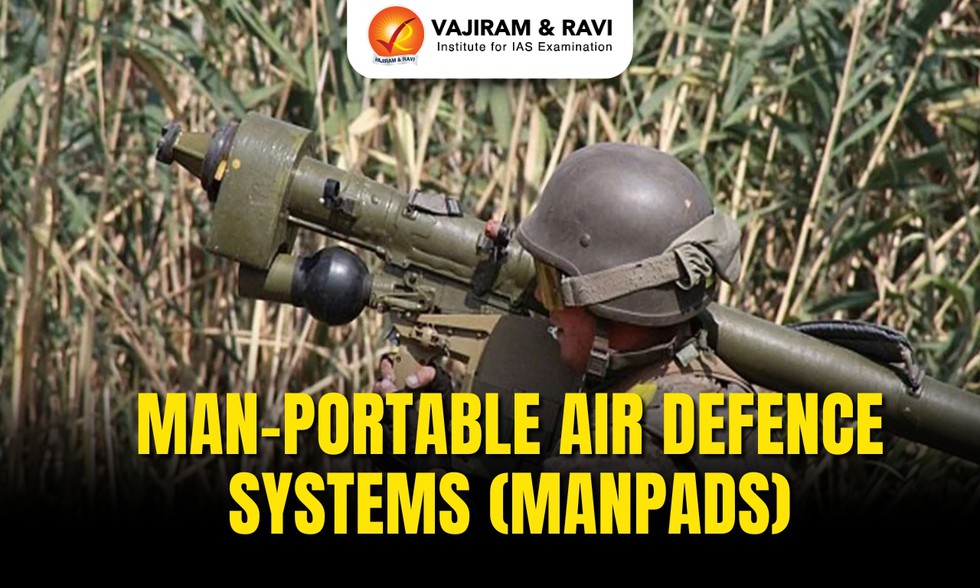
About Man-Portable Air Defence Systems (MANPADS):
- MANPADS are surface-to-air missiles that can be fired by an individual or a small team of people against aircraft.
- These weapon systems often are described as shoulder-fired anti-aircraft missiles.
- The United States and the Soviet Union first deployed MANPADS—the Redeye and Strela systems, respectively—in the 1960s to provide their infantries with portable anti-aircraft weapons.
- The militaries of many countries across the world operate MANPADS, although only few countries, including India, produce them.
- The most famous MANPADS are the US-made ‘Stinger’ and the Soviet 9K32 Strela-2, or simply ‘SA-7' with the China-made ‘FN-16’ being the latest entrant.
- Three general types of MANPADS exist: command line of sight, laser guided, and infrared seekers.
- Command line-of-sight MANPADS are guided to their targets through the use of a remote control.
- Laser-guided or laser beam rider MANPADS follow a laser projected onto the target.
- The most common MANPADS, frequently called heat seeking missiles, however, are infrared seekers that acquire their target by detecting the heat of an aircraft’s engine.
- Most MANPADS consist of:
- a missile packaged in a tube;
- a launching mechanism (commonly known as a “gripstock”); and
- a battery.
Current Affairs
Dec. 15, 2025
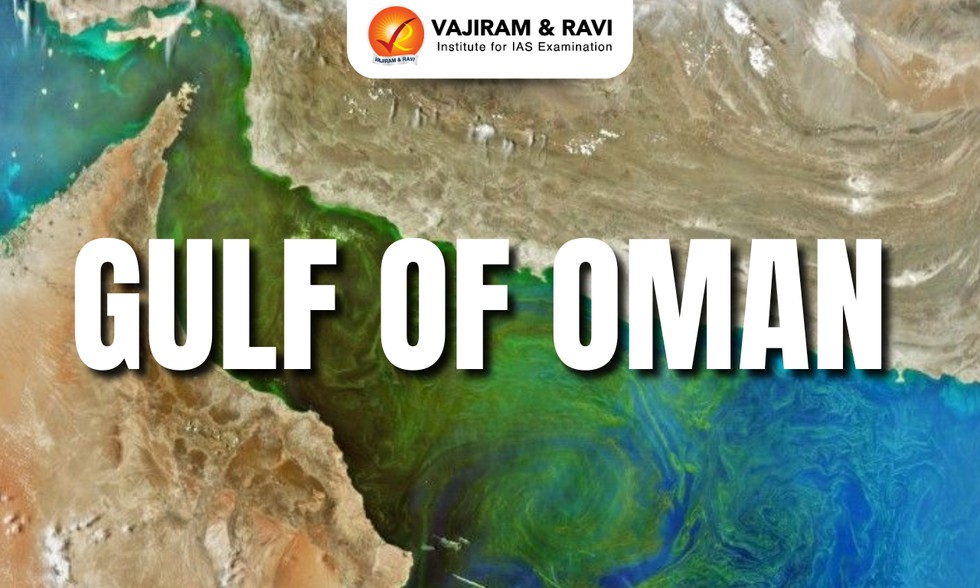
About Gulf of Oman:
- The Gulf of Oman, also known as the Gulf of Makran, is the northwest arm of the Arabian Sea.
- It forms the only entrance to the Persian Gulf from the Indian Ocean.
- It connects the Arabian Sea with the Strait of Hormuz, which then empties into the Persian Gulf.
- Bordering Countries: It is bordered by Pakistan and Iran in the north, by the United Arab Emirates in the west, and by Oman in the south.
- The gulf is relatively shallow because of its origin as a fissure in the mountain spine now divided between Iran and Oman.
- Some of the significant islands that are located in the Gulf of Oman include Sheytan Island, Al Fahal Island, Dimaniyat Islands, and the Sawadi Islands.
- The major international shipping ports that are situated in the Gulf of Oman include Port Sultan Qaboos Muttrah in Muscat, Oman; Chabahar Port in Iran; the Port of Fujairah and Khor Fakkan Container Terminal in the United Arab Emirates.
- Roughly one-third of the world’s oil is exported via the Strait of Hormuz and the Gulf of Oman.
Current Affairs
Dec. 15, 2025

About Chakrashila Wildlife Sanctuary:
- It is locatеd in thе Kokrajhar and Dhubri districts of Assam.
- The sanctuary is well-known as the second protected habitat for the endangered golden langur.
- There are two lakes (Dheer Beel and Diplai Beel) on either side, which are integral to the ecosystem of the sanctuary.
- Flora:
- The vegetation of the sanctuary is predominantly tropical moist deciduous forests, mixed deciduous forests, and semi-evergreen forests.
- Sal tree is a dominant tree in this forest.
- Fauna:
- It is home to various species, including elephants, tigers, leopards, clouded leopards, sambar deer, barking deer, and gaur.
- The sanctuary is also home to several species of birds, including the endangered Bengal Florican, Great Hornbill, and White-winged Wood Duck.

